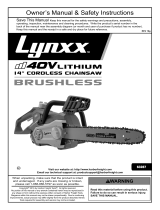
ENGLISH
4
• Only use replacement bars and chains specified
by the manufacturer. Incorrect replacement bars and
chains may cause chain breakage and/orkickback.
• Follow the manufacturer’s sharpening and
maintenance instructions for the saw chain.
Decreasing the depth gauge height can lead to
increasedkickback.
The Following Precautions Should Be
Followed to Minimize Kickback:
1 . Grip saw firmly. Hold the chain saw firmly with both
hands when the motor is running. Use a firm grip
with thumbs and fingers encircling the chain saw
handles. Chain saw will pull forward when cutting on the
bottom edge of the bar, and push backward when cutting
along the top edge of thebar.
2 . Do not overreach.
3 . Keep proper footing and balance at alltimes.
4 . Don’t let the nose of the guide bar contact a log,
branch, ground or otherobstruction.
5 . Don’t cut above shoulderheight.
6 . Use devices such as low kickback chain and reduced
kickback guide bars that reduce the risks associated
withkickback.
7 . Only use replacement bars and chains specified by
the manufacturer or theequivalent.
8 . Never let the moving chain contact any object at the
tip of the guidebar.
9 . Keep the working area free from obstructions such
as other trees, branches, rocks, fences, stumps, etc.
Eliminate or avoid any obstruction that your saw chain
could hit while you are cutting through a particular log
orbranch.
10 . Keep your saw chain sharp and properly tensioned.
A loose or dull chain can increase the chance of
kickback. Check tension at regular intervals with the
motor stopped and tool unplugged, never with the
motorrunning.
11 . Begin and continue cutting only with the chain
moving at full speed. If the chain is moving at a slower
speed, there is a greater chance for kickback tooccur.
12 . Cut one log at atime.
13 . Use extreme caution when re-entering a previous
cut. Engage ribbed bumpers into wood and allow chain
to reach full speed before proceeding withcut.
14 . Do not attempt plunge cuts or borecuts.
15 . Watch for shifting logs or other forces that could
close a cut and pinch or fall intochain.
Kickback Safety Features
WARNING: The following features are included
on your saw to help reduce the hazard of kickback;
however such features will not totally eliminate this
dangerous reaction. As a chain saw user do not rely
only on safety devices. You must follow all safety
precautions, instructions, and maintenance in this
manual to help avoid kickback and other forces which
can result in seriousinjury.
• Reduced-Kickback Guide Bar, designed with a small radius
tip which reduces the size of the kickback danger zone on
bar tip. A reduced - kickback guide bar is one which has
been demonstrated to significantly reduce the number
and seriousness of kickbacks when tested in accordance
with safety requirements for electric chainsaws.
• Low-Kickback Chain, designed with a contoured depth
gauge and guard link which deflect kickback force
and allow wood to gradually ride into the cutter. A
low-kickback chain is a chain which has met kickback
performance requirements of ANSI B175.1–2012.
• Do not operate chain saw while in a tree, on a ladder, on a
scaffold, or from any unstablesurface.
• Hold tool by insulated gripping surfaces when performing
an operation where the cutting tool may contact hidden
wiring. Contact with a “live” wire will make exposed metal
parts of the tool “live” and shock theoperator.
• Do not attempt operations beyond your capacity or
experience. Read thoroughly and understand completely
all instructions in thismanual.
• Before you start chain saw, make sure saw chain is not
contacting anyobject.
• Do not operate a chain saw with one hand! Serious injury
to the operator, helpers, or bystanders may result from
one handed operation. A chain saw is intended for two-
handed useonly.
• Keep the handles dry, clean, and free of oil orgrease.
• Do not allow dirt, debris, or sawdust to build up on the
motor or outside airvents.
• Stop the chain saw before setting itdown.
• Do not cut vines and/or small underbrush.
• Use extreme caution when cutting small size brush and
saplings because slender material may catch the saw
chain and be whipped toward you or pull you offbalance.
WARNING: Some dust created by power sanding,
sawing, grinding, drilling, and other construction
activities contains chemicals known to the State
of California to cause cancer, birth defects or
other reproductive harm. Some examples of these
chemicalsare:
• lead from lead-based paints,
• crystalline silica from bricks and cement and other
masonry products, and
• arsenic and chromium from chemically-
treatedlumber.
Your risk from these exposures varies, depending on how
often you do this type of work. To reduce your exposure to
these chemicals: work in a well ventilated area, and work with
approved safety equipment, such as those dust masks that are
specially designed to filter out microscopicparticles.
• Avoid prolonged contact with dust from power
sanding, sawing, grinding, drilling, and other
construction activities. Wear protective clothing and




















